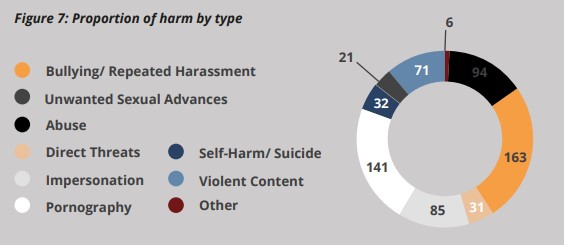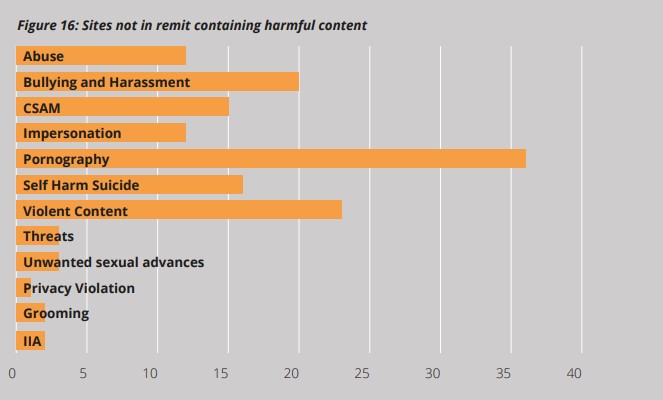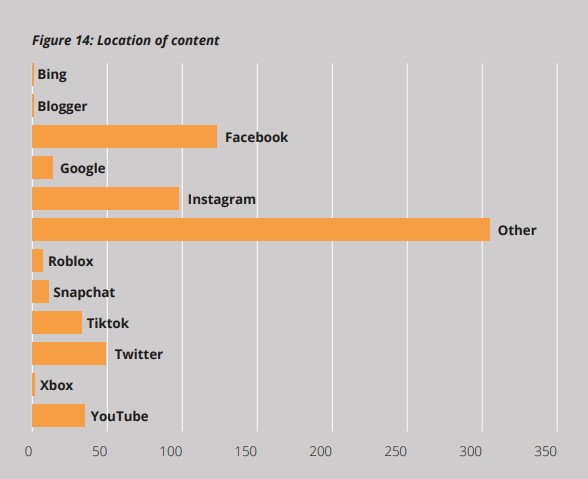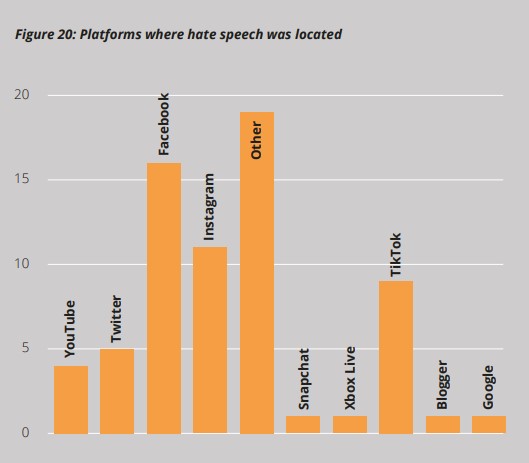Online Pornograhpy Ranks #2 for Reported Harmful Content on the Internet
The Reports Harmful Content (RHC) organization is a impartial dispute resolution service that works with organizations and users to report content that is deemed harmful. What is harmful is, obviously, very subjective so to address they analyzed community guidelines across multiple industry platforms and defined eight (8) content types that fit into the harmful classification:
- Abuse
- Bullying and Harassments
- Threats
- Impersonation
- Unwanted Sexual Advances
- Violent Content
- Self-harm/Suicide Content
- Pornographic content
In 2020 thy released their second findings report that works to analyze the type of harmful content online, and the platforms they exist on. Their insights were based on 644 unique reports submitted in 2020, a 292% increase from the first report in 2019.
Pornography came in second, by a large margin, just behind Bullying / Repeated Harassments.

If we consider the year we had with the pandemic, and if we spend any time online, the fact that Bullying / Repeated Harassment is #1 should not be a surprise. In fact, we would have expected there to be a wider margin between that content type and everything else.
Online Pornography Takes Lead on Non-standard Platforms / Sites
Online pornography was the number one harmful content reported on sites outside of RHC’s remit, appropriately captured as “other”.
This means content on sites, platforms, that are not the more common platforms like Blogger, Twitter, Facebook, etc… They were most likely private sites with little to no way of contacting, or identifying, the operator.

Which also coincides with where the content itself was located:

This makes perfect sense when you look at what is happening online. You would expect bullying and harassments to take the lead on social platforms, and that’s exactly what you see when you look at that specific content type:

Online pornography is a fundamentally different beast, and while platforms like Twitter do a bad job of this type of filtering, others like Facebook, and Google are doing an exceptional job against this type of content. The same can’t be said for the rest of the internet, and mirrors what we see on our platform as a DNS resolver.
Males Take Lead in Reporting Online Pornography
RHC also found that men were twice as likely to be searching for harmful content pornographic content than women (66% for men vs 34% for women). They go on to divide their demographics into these age categories for pornography:
- 19 – 30 (54%)
- 31 – 50 (26%)
- 13 – 18 (11%)
- 50+ (8%)
In the most common age category, 19 – 30, 67% of the reporters were males. When we look at our own internal data, this resonates; males lead the reporting by a very wide margin. They go on to offer the following thinking on why that is and we felt it was worth sharing in its entirety:
It is evident then that younger males are the most at risk of actively searching for pornographic content online. Rissel et al (2016) found that younger individuals had higher rates of reporting a bad effect from pornography, which may include guilt as a result of anti-pornography discourse in educational materials which could, in turn, run the risk of inculcating self-hatred in young people who consume pornography. Chelsen (2011) also found that the more time a student spent accessing pornographic content online, the more likely they were to report feeling guilty about it. One potential explanation for this could be that these young men are reporting this content as a way to alleviate and manage the guilt they feel about accessing it. More research should be done in this field in order to understand whether guilt is driving young men to report pornography in order to manage their feelings.
I personally found this last bit interesting, as it resonated with an issue that occurred with a young cousin (< 13) whom had a similar experience.
They stumbled onto a pornographic site and suffered extreme remorse and guilt as it conflicted with what he was being taught in school (for context he is in a Christian school). He was visibly disturbed because a) he was not sure what he was watching at first, but then b) he couldn’t stop himself from continuing to watch all while acknowledging that it was something that was not aligned with what he was being taught.
His struggle became physical as he made himself sick with worry and fear that he would be punished. It was the first time I had personally experienced this type of response, but has not been the last working with a number of our free and paying customers.
Platforms like CleanBrowsing are incredible resources to combat some of the issues identified in this report, especially online pornography. We built the platform specifically to tackle that “other” segment that is outside of RHC’s reach, but is quickly becoming the fastest growing segment of harmful content. If this is something you struggle with, we encourage you to try our Free filters, and if you need more granular control our paid services.
References
Rissel, C., Richters, J., de Visser, R., McKee., A, Yeung, A. & Caruana, T (2016). A Profile of Pornography Users in Australia:
Findings From the Second Australian Study of Health and Relationships. The Journal of Sex Research. 54:227240.
Chelsen, P. (2011). An examination of Internet pornography usage among male students at Evangelical Christian colleges.
Retrieved from https://www.proquest.com/docview/919995526?pq-origsite=gscholar&fromopenview=true